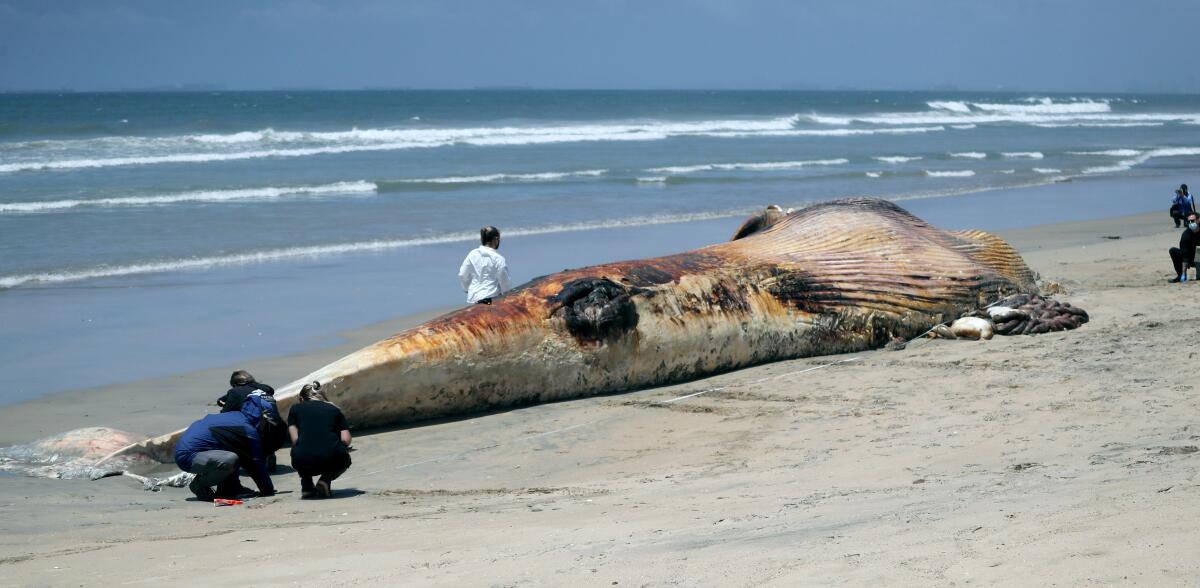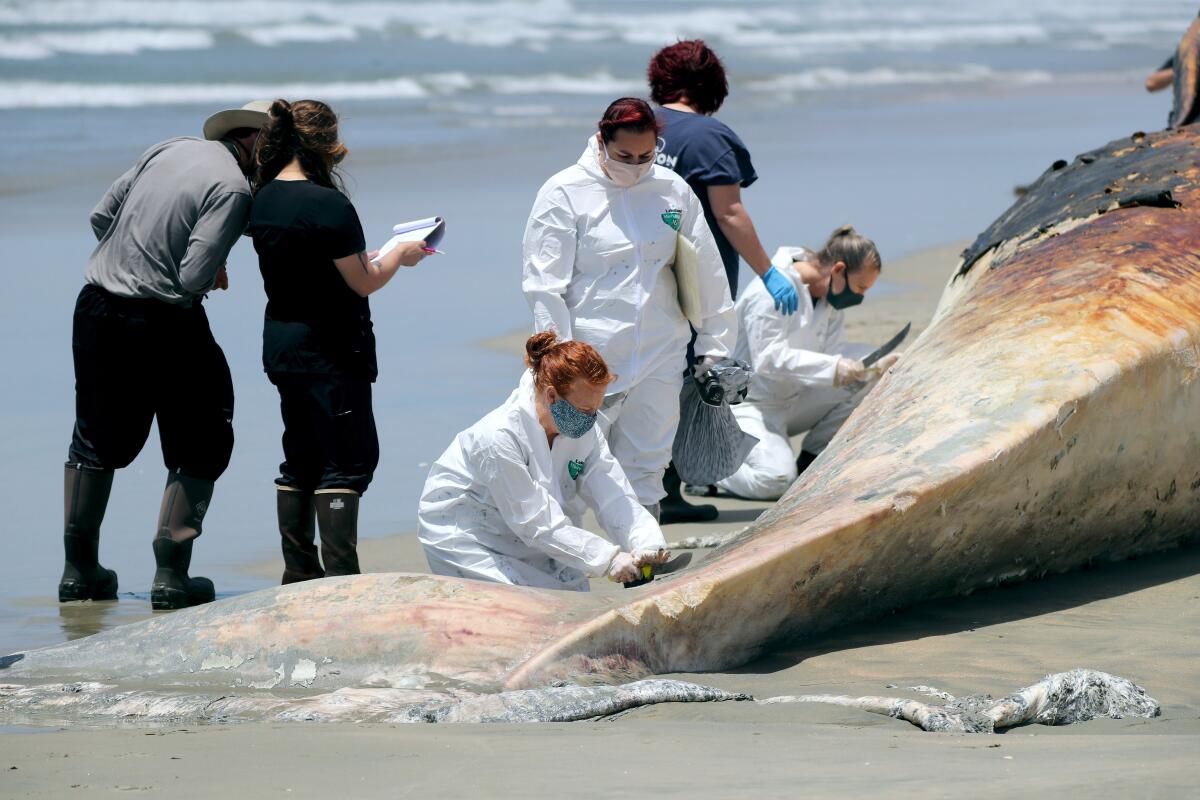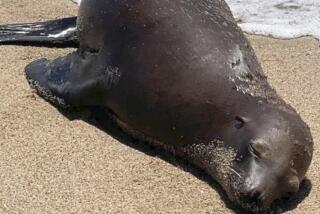A whale carcass was towed to sea in San Diego. Now it’s back, rotting on an O.C. beach

SAN DIEGO — Pushed and pulled by competing winds and currents in the Pacific, the carcass of an endangered fin whale struck by an Australian warship drifted back toward shore and washed up in Huntington Beach, making for an imposing, putrid spectacle.
The beaching adds to the 65-foot-long creature’s weeks-long circuitous journey — from being killed at sea to being unknowingly brought into Naval Base San Diego, then being towed back to sea and finally floating back to the coastline.
That journey will come to a definitive close Saturday, when Escondido-based KD Farms Trucking will use heavy equipment to break up the decomposing remains and haul them away to a landfill.
In the meantime, the whale, a female, is continuing to draw crowds at Bolsa Chica State Beach, where it first appeared about 5:45 p.m. Wednesday. The wide, 3-mile stretch of sand gets an estimated 3.5 million visitors a year.
“It’s a big curiosity,” State Parks Supt. Kevin Pearsall said. “It seems to be a mystical ambiance of just, ‘Wow, it’s so huge.’”
The dead whale was first discovered May 8 after the Australian Royal Navy’s HMAS Sydney berthed at Naval Base San Diego. The whale, along with a 25-foot-long fin whale calf, had apparently been struck while the Hobart-class guided missile destroyer was conducting exercises in Southern California-area waters with the U.S. Navy.
The bodies of both whales then remained wrapped around the ship’s bow, held in place by pressure as the boat moved forward. The carcasses surfaced when the ship finally stopped.
Experts say it isn’t unusual for large vessels to strike fin whales — who feed on krill in large numbers about 10 to 20 miles offshore — without knowing.
The calf, which had sustained more damage, was trucked to a landfill.
The larger whale was towed by boat, contracted by the Navy, about 50 miles back out to sea, according to U.S. Navy Third Fleet Cmdr. Sean Robertson.
The National Oceanic and Atmospheric Administration used computer modeling of currents and winds to help determine the best spot to drop the carcass — ultimately somewhere between San Clemente Island and Catalina Island.
But the modeling predicts movement within only about a five-day window, said Justin Greenman, NOAA’s assistant coordinator for the California Marine Mammal Stranding Network. “After that, conditions can change,” he said. “We can only predict so far.”
Carcasses, bloated as gasses build up inside, can act as sails as the wind hits the large surface area.
“It usually blows with the wind,” said Ryan Lawler, owner of Pacific Offshore Expeditions, an ocean guide company based in Newport Beach.
Instead, this whale was carried northeast toward Orange County by what Greenman called “a crazy set of currents and winds.”
“We did not think it was coming back to shore, at least based on our models,” he said. “It’s an unfortunate situation.”
Lawler, no stranger to whale carcasses, found the animal on May 13 about 10 miles east of San Clemente Island.
“That’s when it was still fairly fresh. There were over a dozen blue sharks on it, going at it,” he said.
He later heard reports of the whale drifting toward Catalina Island. On Tuesday, he found it again. The next day, it was about 10 miles off Huntington Beach. By then it was too fetid for predator interest.
When the carcass washed ashore Wednesday evening, it was obvious it was the same animal that had been towed from San Diego, Greenman said. The tow company had left the line attached, in case it needed to be towed again, and there were visible marks where NOAA scientists had previously extracted tissue samples at the naval base.
The whale’s position in the water at the base had made it difficult for researchers to conduct any other examinations. But since it’s been beached, researchers have spent more time with the body, taking additional measurements and samples, Greenman said.
The carcass is now in an advanced state of decay, emitting a gut-turning stench. But that hasn’t kept the looky-loos away.
The whale has been surrounded by a steady crowd of 40 to 50 onlookers at any given time, kept at a 15- to 20-foot distance by a rope barrier, Pearsall, the state parks superintendent, said.

At least a few have been so overcome by the stink that they’ve vomited, he added.
“We’re advising everybody to not approach downwind. A couple of people are forgetting that.”
The whale is in no condition to be towed back to sea again, so land disposal was determined to be the best option at this point. It will cost upward of $20,000, Pearsall said.
Because the whale ended up on a state beach, the state appears to be the one left with the tab. But state officials are “in dialogue” with the U.S. Navy in hopes that the military will step in to help pay, he said.
“The state of California started the process of moving it. At this point, we’re on the hook,” Pearsall said. “At the end of the day, we need to get this whale off here.”
Crews were expected to begin staging equipment Friday afternoon and start the removal process Saturday morning.
Davis writes for the San Diego Union-Tribune.
More to Read
Sign up for Essential California
The most important California stories and recommendations in your inbox every morning.
You may occasionally receive promotional content from the Los Angeles Times.











